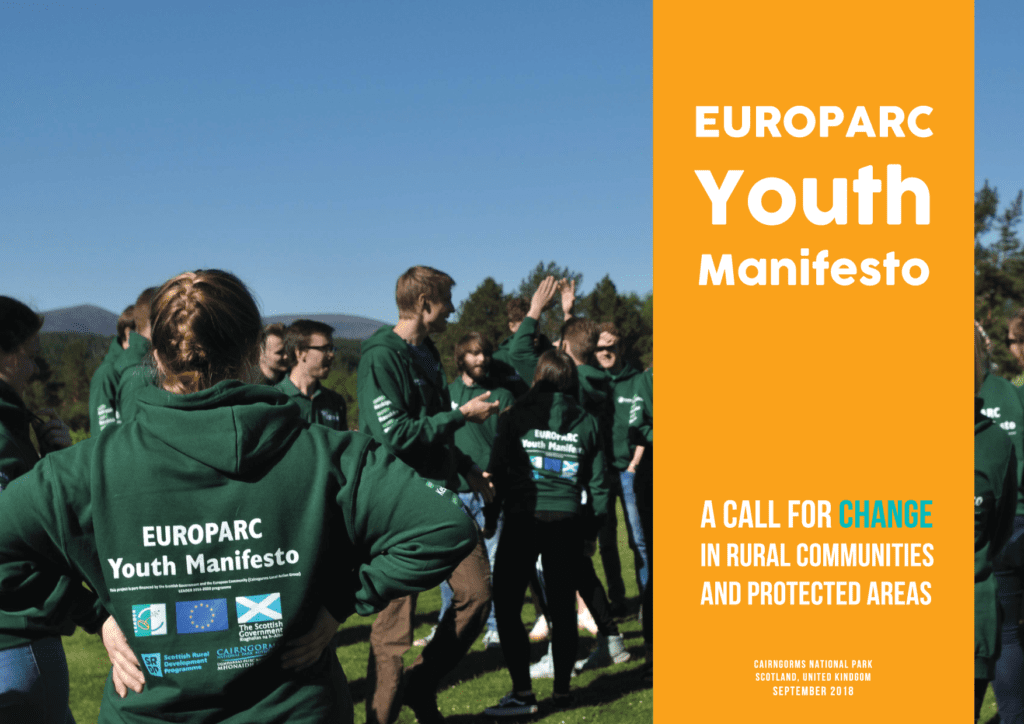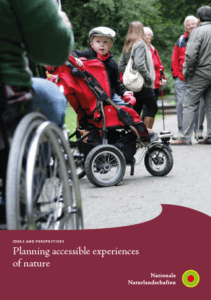Transboundary Parks Award 2018 – Pasvik-Inari Trilateral Park
Pasvik Inari Trilateral Park Transboundary Area, Oleg Pershin
The EUROPARC’s Transboundary Parks Programme aims to promote and facilitate transboundary cooperation between European Protected Areas. Since 2003 the Basic Standards evaluation system was launched, 23 European Protected Areas have been successfully certified as 10 Transboundary Parks under the EUROPARC programme “Transboundary Parks – Following Nature’s design”. Every year during EUROPARC Conference we celebrate success with our Transboundary Parks at the Award Ceremony.
In 2018 the Awards goes to…
PASVIK-INARI TRILATERAL PARK
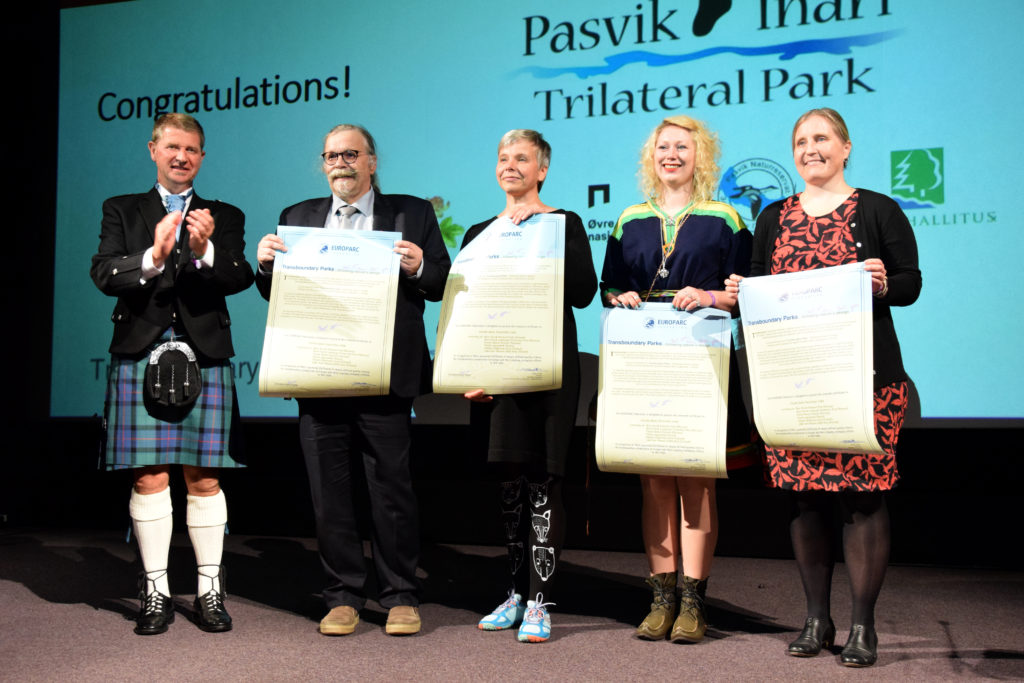
Ignace Schops handing in the Certificates of the Transboundary Awards 2018 to Pasvik-Inari Trailateral Park representatives.
The Pasvik-Inari Trilaterla Park embraces the following 6 Protected Areas:
- Øvre Pasvik National Park (Norway)
- Øvre Pasvik Landscape Protection Area (Norway)
- Pasvik Nature Reserve (Norway)
- Pasvik zapovednik (Russia)
- Vätsäri Wilderness Area (Finland)
- Lake Inari Natura 2000 Area (Finland)
Pasvik-Inari Trilateral Park entity was established in 2008 as a result of long-term cooperation between the nature protection authorities in Norway, Russia and Finland dating back to the early 1990’s. The Trilateral Park consists of six nature protection areas; three areas in Norway, one in Russia and two in Finland and the strengths of the cooperative work lay on the unique connections between Sámi, Norwegian, Russian and Finnish people and their cultural heritage. Nature protection and management, environmental awareness and promotion of sustainable nature-based tourism are the key elements of their work.
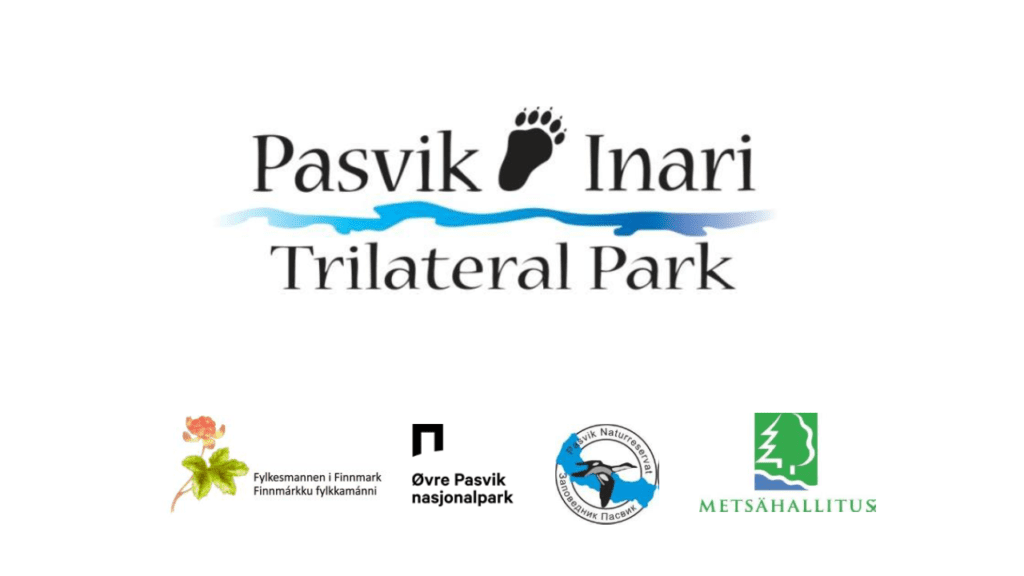
The Pasvik Inari Trilateral Park
The lush valley of the Pasvik river stretches from Lake Inari in the south towards the Barents Sea in the north, appearing as a vital nerve in the mosaic landscape of small lakes, mires and wet lands and virgin Taiga forests. The region comprises a unique nature system where European, Eastern and Arctic species meet. Here, some of the species reach the ultimate limits of their distribution. The area is also an important nesting and resting place for a large number of migratory birds.
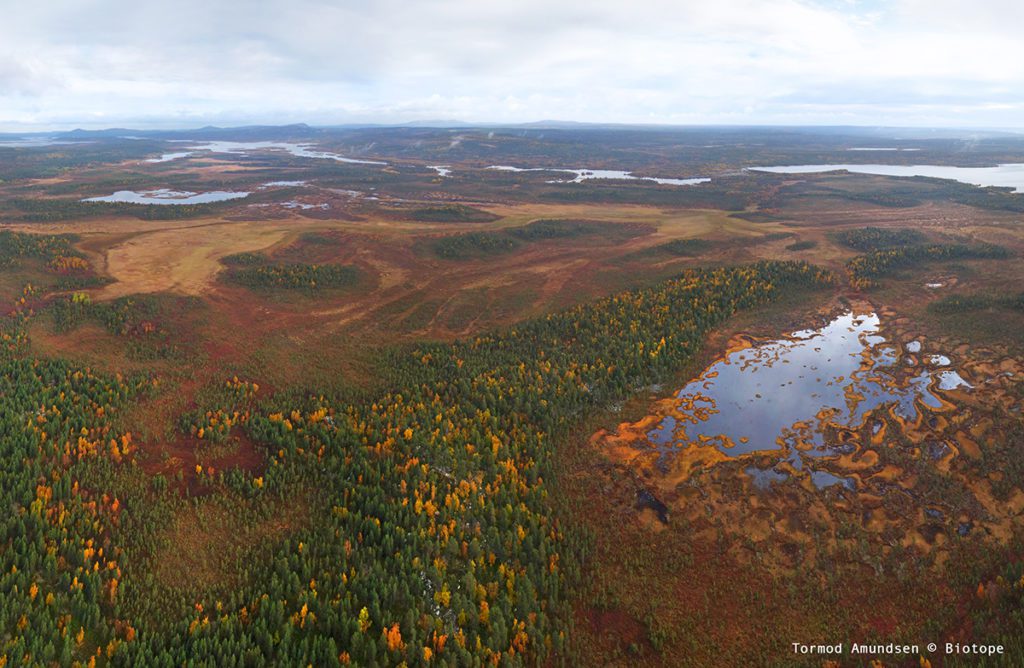
Landscape mosaic by Tormod Amundsen, Biotope_Pasvik Inari Trilateral Park
Three countries, three different currencies, three different time zones and six languages work together every day and ensure long lasting cooperation on high level. (Verifier’s report)
The Pasvik-Inari region is a meeting point for different cultures too. Different Sámi people live in the area: the Northern, Inari and Skolt Sámi. Since the Early Middle Ages, Finns, Norwegians and Russians have also settled in the region. Although different cultures coexist in the area and have learned a lot from each other, they have each retained their distinctive traditions.
The Trilateral Park produces regularly informative products about natural and cultural heritage of the area in all the native languages and in English targeted especially for school children – games are their speciality! The partners and stakeholders of the parks work together in different projects to promote sustainable nature-based tourism to support sustainable local development in the border areas. Pasvik-Inari cooperation participates actively in the development of Green Belt of Fennoscandia initiative.
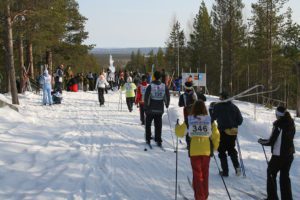
Ski_Barentsski Event by Yngve Beddari_Pasvik Inari Trilateral Park
Get to know more about the Transboundary Parks Programme and the other members of the TransParcNet.
EUROPARC Youth Manifesto launched at EUROPARC Conference 2018!
The EUROPARC Youth Manifesto was launched today (21 September ) to over 400 delegates at EUROPARC Conference 2018, in Aviemore – Cairngorms National Park.
Young people are keen to be involved in the decision making processes when it comes to sustaining the rural landscape. All summer young people from across Europe have been working together to put together their vision on the most important aspects of living, learning and working in protected areas and rural communities and this Manifesto offers practical ways for change.
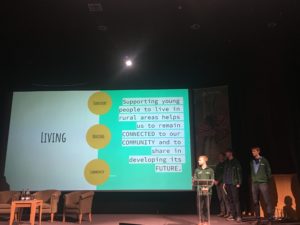
Young people just want to be heard and entrusted to help protect and conserve their local environments.
explained Laura Peters, the Youth Representative on the EUROPARC Council, adding, “we want to be involved in helping to make thriving, sustainable communities with training and job opportunities so that we can remain in our local areas and not lose touch with our cultural heritage. This Manifesto must be the catalyst to making that happen in Scotland and across Europe”
Grant Moir CEO of the Cairngorms National Park Authority agrees, “Young people are the future of the national parks and protected areas we have in Europe; they are the decision-makers of tomorrow. This Manifesto is a both a challenge and a source of inspiration for decision makers in protected areas and rural communities to find ways to engage with their local youth and listen to their ideas.”
The EUROPARC Youth Manifesto
In spring 2018 a group of youth from across seven countries gathered to create the EUROPARC Youth Manifesto, a document that shall draw the attention of Protected Areas, environmental organisations and rural communities to the challenges of their youth – inspiring them to meaningfully engage with young people in their area for tackling those challenges together.
The EUROPARC Youth Manifesto points out the main challenges young people face living, learning and working in rural communities and Protected Areas, but above all aims to inspire and encourage decision-makers, public authorities and managers to take the first step towards practical involvement of young people. The youth is ready to do their bit, keen to engage in exchange to learn and work for in partnership with those governing our rural and Protected Areas:
Get inspired by the EUROPARC Youth Manifesto…
Click on the image to download the English Version of the Youth Manifesto
Read more about the Youth Manifesto at www.europarc.org/youth-manifesto
This trans-national partnership project has been led by the Cairngorms National Park Authority with project partners: EUROPARC Federation, Cairngorms Trust, Rieskas LEADER Finland, Keskipiste LEADER, Ravakka LEADER, Scottish Natural Heritage and Young Scot.
Next EUROPARC Webinar: Accessibility and inclusion in Protected Areas
Contact with nature and enjoyment of the outdoors should be accessible experiences to every person. Protected Areas administrations play a fundamental role in providing opportunities to people with physical or intellectual disabilities, by creating accessible infrastructure for visitors and inclusive programmes and activities.
- 11th October 2018, 11:00 CEST (Central Europe Summer Time)
- Register here
Accessibility and inclusion in Protected Areas
From trail design to volunteering programmes
Several European Protected Areas are improving accessibility for visitors with reduced mobility, especially regarding accessible trail planning and design and barrier-free visitor centres, birdwatching hides or viewpoints. In some parks, there are also joelettes and other soft-mobility solutions available for visitors, and often, too, signage and communication tools are adapted to visually handicapped visitors or guests that are hindered by long, complicated texts.
Simultaneously, Parks strive for the inclusion of people with disabilities in the Park’s daily activities. Frequently, handicapped people are asked for technical advice on the planning of trails and infrastructure, and many have the opportunity to join special volunteering programmes for conservation work, supporting activities such as mowing meadows or repairing paths. In these cases, a strong cooperation between Park administrations and local social institutions or NGOs is fundamental for the implementation of volunteering programmes. By doing so, Parks not only have the chance to bring people closer to nature – they can provide life-changing experiences in their community, both for visitors and for the Park staff.
The secret of success lies in the attention you pay to each and every service you provide,
is an important recommendation from the manual “Planning Accessible Experiences of Nature”, produced by EUROPARC Germany. Although many parks might consider an expensive effort, according to EUROPARC Germany there are many ways, often easy and affordable, to improve the experience of disabled visitors. Observation and personal contact with visitors are fundamental, but also building up connections with local institutions, and exchanging experiences with other Parks, will certainly help you find new ways to improve accessibility and inclusion in your Park.
In this EUROPARC Webinar…
Anne Schierenberg and Kerstin Emonds from EUROPARC Germany will introduce us the manual “Planning Accessible Experiences of Nature”, and give us some hints on what you can do in your Park.
Our invited case study presenter from Germany will share examples of trail design and how they are developing volunteer programmes. Our invited guest from England will focus on the human dimension, explaining how the Park is working with long-term disabled volunteers and with a local senior residence, and also how they are building the capacity of the Park staff to work with volunteers with mental health issues.
Anne Schierenberg is the Head of Civil Engagement with EUROPARC Germany since 2003. Anne studied landscape planning at the Technical University of Berlin, graduating with a degree in engineering, and completed a voluntary ecological year at BUND Pfullendorf/Baden-Württemberg.
Kerstin Emonds is Officer for Accessibility and Inclusion with EUROPARC Germany since 2009. Kerstin also studied landscape planning at the Technical University of Berlin and after her qualification in regional management, she worked in this field for many years.
Case Study 1
Eichsfeld-Hainich-Werratal Nature Park: How we work together with people with disabilities
By Johannes Hager, Eichsfeld-Hainich-Werratal Nature Park, Germany
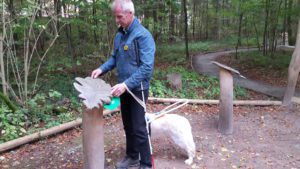
Tourist in the special trail for blind visitors at the Eichsfeld-Hainich-Werratal Nature Park, Germany – Photo by Uwe Mueller
The Eichsfeld-Hainich-Werratal Nature Park, located in the centre of Germany, promotes inclusion of people with disabilities in various manners. In the outdoor facilities of the information centre “Alter Wasserturm”, there is a path especially adapted for blind visitors, developed in cooperation with a regional NGO for visually handicapped people. In addition, the Park administration is currently evaluating and optimising their cycling routes in cooperation with a local handbike-user. The Park is also offering opportunities for volunteers with intellectual disability, to support the Park in practical conservation work.
Dr. Johannes Hager is the Director of the Eichsfeld-Hainich-Werratal Nature Park since 1992. Dr. Johannes Hager is Biologist with PhD in Ecology, having studied in Bonn, Innsbruck (Austria), Crete (Greece) and Bielefeld (Germany). Formerly, he worked as university assistant in Bielefeld, and as a consultant in Santo Domingo (Dominican Republic) in several projects related to wildlife and biodiversity protection.
Case Study 2
The Human Element – the involvement of people with disabilities in volunteering with the North York Moors National Park
By Ryan Chenery, North York Moors National Park, United Kingdom
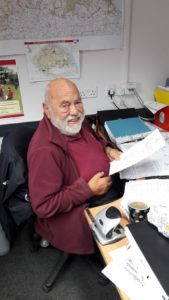
Paul Hepworth is one of the volunteers who works in the Volunteering Administration department of the North York Moors National Park (UK). Paul gave an interview in which he talks about how much volunteering has changed him. Paul is physically disabled (spinal injury) and has kidney disease and therefore undergoes dialysis twice a week. Paul has been with the National Park for 1 year and volunteers 3 days a week every week!
The motivation of the North York Moors National Park to work with people with disabilities stems from one of their ten National Park Values – Promoting opportunities for everyone to get involved with the National Park. Indeed, the Park has a long history of working with volunteers with disabilities who contribute to both office and field work. Over the years, people have volunteered for a whole variety of reasons, but is becoming more common that people are volunteering due to health – including mental health. A number of Park staff said that volunteers want to talk about their mental health issues, but as staff felt ill-equipped to deal with this, the Park has trained 15 staff in mental health first aid this year, with a further 20 planned for September.
In addition to practical work out in the Park, the North York Moors is also engaging with disabled persons within their offices. They have 2 volunteers with disabilities participating in administrative roles in the Volunteering and IT Teams, who are both undertaking valuable work – and the opportunities have been created specifically to cater for their particular disabilities.
Ryan Chenery is the Volunteers Officer of the North York Moors National Park. Original from Barbados, Ryan moved to England in 2014 to work for RSPB and since 2017 he is responsible for overseeing the volunteer journey of every new Park volunteer – from recruitment and interview, to induction and training. Ryan also leads on the development and upskilling of volunteers and community involvement in volunteering across the National Park.
How to join?
Webinars are open not only to EUROPARC members – but to everyone with an interest in Protected Areas. Participation is free but registration is necessary.
You can join in from anywhere: you will just need a device with internet connection. EUROPARC webinars are held in English and last around 1:15 min. Participants have the chance to direct their questions to the invited speakers during the final discussion.

